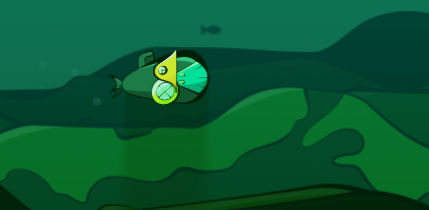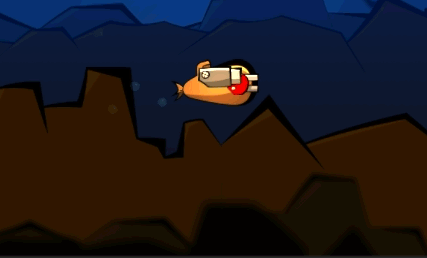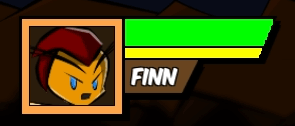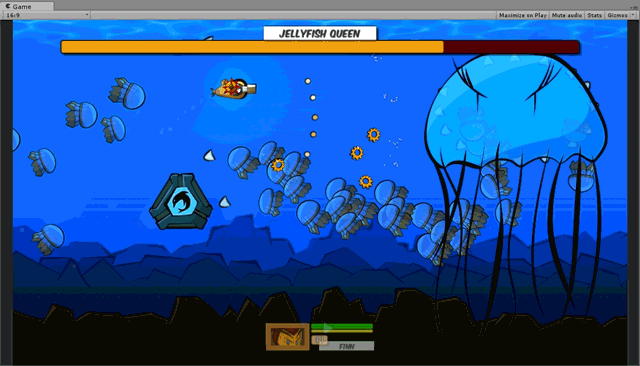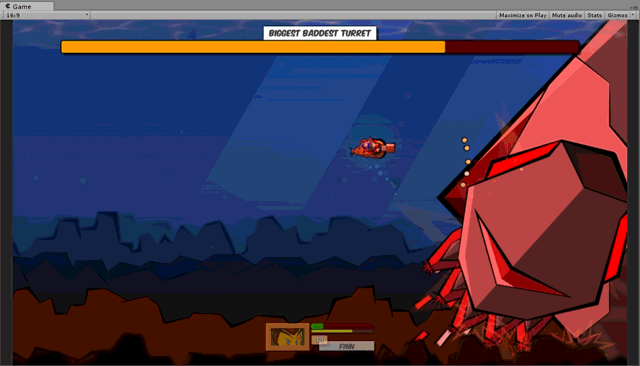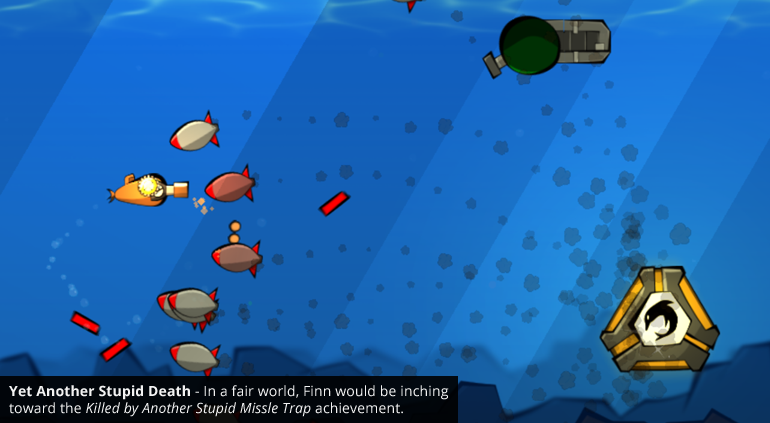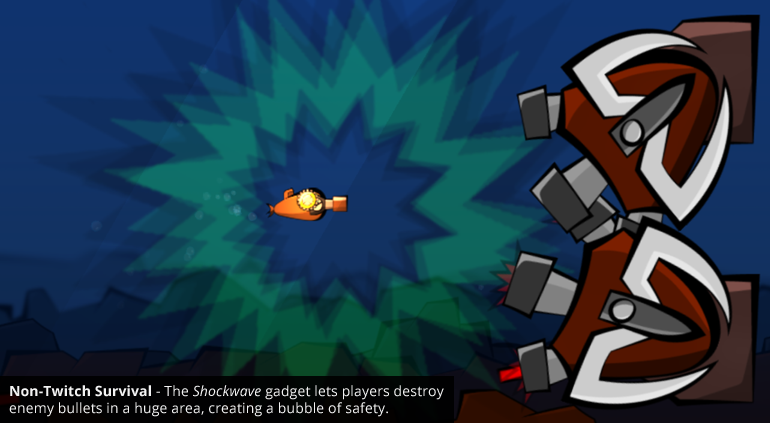One of the most commonly asked questions after we demo the game at conventions and the like is, “Why is it only 3 levels! We want to play more!” That is a really humbling question to hear: it means that we are doing something right. The honest answer is that we just don’t have the content to support more levels yet. We have been polishing up and adding new features to the existing content and slowly expanding the game, but we haven’t pushed the scope of the game for a while.
But that isn’t the case anymore.
These last couple of weeks have been more focused on getting ready for the new push for content after those initial levels. We are starting to magnify the scope of the game to get a better feel of how the game is at later levels. What better way to signify this than the creating on new areas, parts, and characters!
Yes, you read right, characters!
Introducing Spike
Unlocks in Fingeance is a topic that we here at Escape Industries take seriously and we want you, the player, to feel rewarded for all of your feats in-game. One of the ways that we hope to achieve this is through characters, and Spike is our first foray into this sphere.
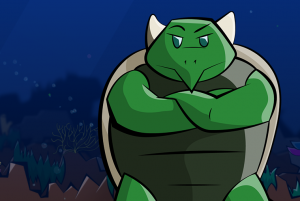 Spike is brute that can take a beating but can dish it right back at you. He puts his body on the line to help defend his comrades from danger. This extends to his initial loadout which emphasizes taking damage head on.
Spike is brute that can take a beating but can dish it right back at you. He puts his body on the line to help defend his comrades from danger. This extends to his initial loadout which emphasizes taking damage head on.
The idea behind new characters that you unlock is that they are more specialized roles and standout personalities within the game, expanding the starting loadout possibilities. We are still testing the waters with adding in new characters and how they will interact with the rest of the team. But we don’t want to spoil too many characters as we want to save some surprises when you guys finally get your hands on the game. So don’t expect a huge expose on the latest characters adding in the game anytime soon.
Expanding Parts
In the spirit of expanding the later content of the game, we’ve been creating new higher tier parts. Some of these will be completely new, but many will be direct upgrades to parts you’ve seen in the past. For example, we’ve recently added the Phantom Gear as a Tier 3 part. This gadget is the upgraded version of a past part called Ghost Gear, and while it is active it will give you’re ship ghostly properties. The ship becomes intangible to all contact (except scrap, for you greedy guppies out there) and emits a haunting trail that damages and chills enemies. 
Preliminary Biome
The other main area that we are focusing on is a new place our heroes will traverse. The next area will be a Kelp Forest. Overgrown with vegetation and algae, this area is an organic locale that our fish friends must navigate through in order to proceed.
Or at least that is the plan anyway.
Right now it is in some very preliminary stages and not really that fleshed out yet, but I wanted to leave you with a very small preview of what we have so far.
So there you have it, as you can see we are starting to slowly make our way towards the “end” of the game rather than just staying in the beginning. We hope you like what you see, and if you want, you can leave a comment below or on our Facebook page as well as tweet at us. Until next time.
Wait, is that… No… It can’t be… can it?
After reworking the Shop Menu and the Character Selection screens I told myself, “No more big systems for a while…”
So naturally, I’m working on another big system.
This time I am reworking the player HUD (Heads-Up Display, for those unaware) that tells the players what is going on with their ships.
Reworked Player HUD
At a glance, it looks pretty similar to the older version aside from the slanted edge. Indeed, not much more info has been added to the HUD… at least at first glance. While it now has that stylish slant it also has the ability to use animations.
So far, I’ve created an intro animation. This will play at the start of a level, when a new player joins, or when you come from the pause or continue screen.
This, as you might imagine, is super slick when multiple players are in the game. Right now, I’m still working on the other HUD states. For instance, the HUD needs to shrink when unused.
Here’s another feature I’ve added:
The health now changes color as you get damaged. The health even begins to flash as you are near death! This is useful for reading health from your peripheral vision. When you’re busy dodging, it’s tough to take a moment and check your health. Now, you don’t have to.
In fact, this feature was suggested by the community. We are always listening to you guys and really do value your opinions and suggestions. Feel free to drop us a line in the comments below or on our various social media channels (Facebook and Twitter).
Firestarter
While I was working the new HUD, Lane got busy making new parts.
The first part, the Firestarter, turns you into a devastating long-range turret. As long as you fire the gadget, you’ll launch explosive fireballs in whichever direction you choose. The longer you use the Firestarter, the faster it will shoot. This comes with a price, however: while shooting, you’re slowed to a near-standstill.
The design goal of the Firestarter is to turn a player into an objective the team must protect. It dishes out unparalleled damage, but its immobile user can be torn apart in seconds by enemy fire. Before, we’d built parts that allow players to tank. Now, we’re making parts that reward tanking.
Teleporter
The second part is called the Teleporter. It… pretty much does what the name suggests. It lets you warp around the battlefield really fast. Or, if you hold it down for a moment, it lets you power up for bigger warps, letting you pull off some pretty impressive defensive tricks.
The goal here is to provide a fun way to boost movement speed without making characters harder to control. In this phase of design, we’re adding several enemies with zone-control attacks and exploitable weak points. As we continue, movement gets more and more valuable. We also wanted a defensive option that doesn’t require fine control of the analog stick. Lastly, teleportation is just plain fun.
Lots of new things being added to the game! Please leave us a message as we do read, listen and respond!
Greetings Friends!
Today’s article is about something we all spend a lot of time doing: dying in video games. Adding death to a game is a lot like cooking with spice: some people don’t like it, many do like it, and to some, the dish is meaningless without it. This article will look at why death is so important, how Fingeance does it, and how you can make death feel awesome (and terrible) in your own game.
Giving the Reaper his Due
Setting aside story, does any element of gaming produce more emotion than player death? We are drawn psychologically to flee from loss, and will spend the same effort to avoid a loss as to make a gain twice as large. From my own experience, no mechanic evokes a spectrum of emotion quite like the death of my avatar. Frustration and anger, yes, but also cunning, humility, and resolve.
Death, and making it feel right, is of paramount importance to game-making. Think back to your most epic game experiences. How many of them involve the death of a hardcore character or the wipe of your raiding party? If none, then answer this: How many experiences were made better by past failures. How many peak moments come from the flush of victory after finally eluding the grisly hand of fate?
Even setting aside emotional impact, death looms large in the gamer’s rational thinking. In many games, it is half of the great binary: win or lose. If a game is like a hurdling race, taking away death isn’t like removing the hurdles. It’s like removing the ground itself. How much do games rely on death? Try playing Starcraft with the Power Overwhelming cheat code. Try god mode in any FPS. Taking away death turns bushwhacking the jungle into mowing the lawn. As plant cliches go, it’s still a cut above watching grass grow, but we’ve still turned smashing baddies into a repetitive chore. Death is important.
The Scales of Life and Death – Death in Fingeance
Early in design, our conversations were dominated by the topic of death. For our genre, we’d decided to mash-up two very different types of games that treat death very differently. On one side, Fingeance gets its hardcore edge from Roguelikes and Shmups. In these games, death is almost always disastrous. Whether you lose a precious continue or your entire progress-so-far, death is a specter to avoid at all costs. On the absolute opposite end of the spectrum, Fingeance is meant to be an inviting party experience. In these games – New Super Mario Bros. Wii & Wii-U are fantastic examples – death is far less catastrophic. The idea of a player sitting out while their friends continue on is anathema to the party experience. Often, these games allow one player to revive the others. In any case, death is always brief, and rarely contains long-term consequences.
To fit these wildly-differing demands, we devised four rules. As you read them, keep in mind that these are intended for team play. Solo play works a little differently (you’ll use up a Continue each time you die). Onward to the rules!
Rule 1. – Death is Temporary.
Mechanic – When your ship explodes, you’ll be back to the fight in a matter of seconds. On death, a countdown timer appears on your health bar. When it hit’s zero, you’re back in the fight.
Purpose – This rule serves Fingeance’s role as a party game. No one likes to sit out. Take Super Smash Bros. for example. Stock Mode is the “pro” way to play, yet the game defaults to Time Mode every time. Why? It keeps players playing and the party going strong.
The bottom line here is simple: Flipper – your ship’s mechanic – does amazing work.
Rule 2. – Death has Lasting Consequences.
Even Flipper can only do so much.
Mechanic – Each time you die, the countdown to your revival takes a little longer. When you finish a level, this effect is wiped. This means that you’ll begin each new level with the shortest possible death-timeout duration. Each player has their own death counter, so your deaths won’t affect your friends.
Purpose – This rule emphasizes the value of skilled play and adds long-term drama to every death. We don’t want a single death to knock a player out of the game, but it should be clear that every life matters. This rule also helps us avoid a problem common to survival-based action games like Hero Siege [Trailer] [Steam]. Often, these games incentivize death, letting players use it as an easy full-heal. In Fingeance, you won’t want to do this, because every death is more punishing than the last.
Rule 3. – Players Succeed or Fail as a Team.
Mechanic – As long as any member of your team survives, you will return to life. If every member of your team is dead, you won’t. On most difficulty settings, your team can spend a Continue to keep going.
Purpose – This rule turns Fingeance into a deeply friendly and team-oriented game. When a player dies, we want that player to actively cheer on his friends. When only one player survives, we want to let that player be the hero, capable of bringing her allies back to the fight. This also means that no one player can drag down the whole team.
On the flipside, this rule means that players can fail as a group. If your team dies enough, and burns through all your continues, it’s the end of the road. The campaign ends. Better luck next time.
Rule 4. – Temporary Losses are Offset by Permanent Gains.
Mechanic – Teams can unlock new characters and parts through play. Your team doesn’t have to beat the game to unlock new stuff.
Purpose – This rule pulls a lot of weight for us. As I mentioned at the start of this article, people are loss-averse. Take, for example, the fact that less than 5% of Diablo 3 characters are hardcore. The offer of permanent rewards does a lot to encourage people to take risks.
Of course, this also does what unlocks do for every game: it lets us gate content. When you first pick up the game, it’s simple, light, and fun, but there’s mysterious LOCKED AWESOMENESS just out of reach. As you play more, the experience becomes richer and more diverse.
Heaping Helpings of Death on a Silver Platter
I hope that, by this point, you’re convinced that death – and making it interesting – is worth your concern. When putting death into your next game, consider these design shortcuts:
Make sure death serves your design goals. Why are deaths in Super Meat Boy [Trailer] [Steam] so fast? Why are deaths in Dark Souls 2 [Trailer] [Steam] so slow? In both cases, the designers have a playstyle they’re trying to promote. In Super Meat Boy, instant respawn promotes a try-fail-try-again approach that fosters incremental improvement and muscle memory. In Dark Souls 2, the long and frustrating death sequences encourage players to pursue thoughtful and cautious strategy. In Fingeance, our death rules encourage players to be adventurous and work as a team.
Let players know death is coming. Last week, Charles and I added damage modeling to the player ships in Fingeance. Suddenly, you don’t need to look down at the UI health bar to know when you’re on the verge of death. We want to avoid the feeling that a death was “cheap” or “unfair.” That feeling seems to happen most when death sneaks up out of nowhere.
Give players multiple routes to avoid death. This is Game Design 101. If a game has only one way to win – as with Monopoly – it’s called a Solved Game. Solved games often have a short lifespan. In Tic-Tac-Toe, for example, children quickly deduce the correct solution, play perhaps once or twice more, then never play again. Consider, then, what you do to your game if you provide only one way to not lose. If, for example, the only way to survive is to dodge bullets, then the player has no choice. They must improve at that one skill to play your game. On the other hand, having multiple ways to avoid death allows strategy and choice – even in the toughest, most action-oriented game. League of Legends and other MOBAs do an excellent job of this. Sure, you may not be able to dodge enemy skill-shots, but you always could have chosen not to engage in the first place. Here are some death-avoidance strategies in Fingeance:
- Dodging – Skills used: twitch reflex, precision control.
- Blocking/Shielding – Skills used: twitch reflex, timing, build optimization.
- Killing Enemies Before they Reach Maximum Threat – Skills used: time management, build optimization.
- Predicting Enemy Attacks – Skills used: pattern recognition, memory.
Communicate what comes next. Charles has written about the importance of animations in adding polish to a game. They also help draw attention to what’s important. In Fingeance, we’re currently working on using animation to convey what happens when you die. Very likely, we’ll show the fishy pilot of your ship swimming to safety, then moments later roaring back in his shiny new ship. This, combined with the HUD reacting to player death (and lines of character dialog reacting to same) combine to communicate “hey. You died. Bummer. Now get ready for Round 2!”
Fin
That’s it for today. Thanks as ever to everyone who sent in feedback last week. Fingeance wouldn’t be the game it is today without you. If you have any comments or questions, I’d be delighted to hear what you think.

